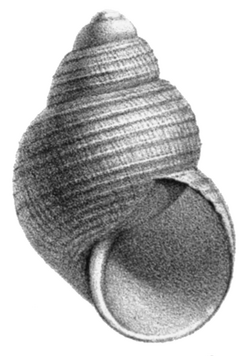Biology:Parafossarulus manchouricus
| Parafossarulus manchouricus | |
|---|---|

| |
| Drawing of an apertural view of the shell of Parafossarulus manchouricus. | |
| Scientific classification | |
| Kingdom: | |
| Phylum: | |
| Class: | Gastropoda
|
| (unranked): | |
| Superfamily: | |
| Family: | |
| Genus: | |
| Species: | P. manchouricus
|
| Binomial name | |
| Parafossarulus manchouricus (Gerstfeldt in Bourguignat, 1860)[2]
| |
| Synonyms[3] | |
|
Bythinia manchourica Gerstfeldt – Bourguignat, 1860 | |
Parafossarulus manchouricus is a species of freshwater snail with gills and an operculum, an aquatic prosobranch gastropod mollusk in the family Bithyniidae.
This species is medically important as a host for the liver fluke Clonorchis sinensis in East Asia.
Subspecies
- Parafossarulus manchouricus japonicus (Pilsbry, 1901)
Description
The shell has 5.5 whorls.[2] The width of the shell is 6 mm.[2] The height of the shell is 10 mm.[2]
The haploid chromosome number of Parafossarulus manchouricus is n=17.[4][5]
Distribution
This species occurs in: Russia (Amur River basin),[6] Japan (Honshū, Kyushu and Shikoku), Korea, Taiwan[7] and China.[8]
The type locality is the Amur River and other rivers in the southern Siberia ("le fleuve Amour et divers cours d'eau de la Sibérie méridionale").[2]
Habitat
Parafossarulus manchouricus lives in shallow ponds and in irrigation channels.[9]
Parasites
This species is a first intermediate host for Clonorchis sinensis.[10]
References
- ↑ IUCN (2013). IUCN Red List of Threatened Species. Version 2013.2. <www.iucnredlist.org>. Downloaded on 13 May 2014.
- ↑ 2.0 2.1 2.2 2.3 2.4 (in French) Bourguignat J. R. (1860). "Catalogue des mollusques de la famille des paludinées recueillis jusqu'à ce jour en Sibérie et sur la territoire de l'Amour". Revue et Magasin de Zoologie, série 2, 12: 531-537. page 535, plate 24, figs. 11-13.
- ↑ World Health Organization (1995). "Control of Foodborne Trematode Infection". WHO Technical Report Series. 849. PDF part 1, PDF part 2. page 125-126.
- ↑ Amany A. Tohamy & Shaimaa M. Mohamed (2006). "Chromosomal studies on two Egyptian freshwater snails, Cleopatra and Bithynia (Mollusca-Prosobranchiata)". Arab J. Biotech. 9(1): 17-26. PDF .
- ↑ Park G. M. (1994). "Cytotaxonomic studies of freshwater Gastropods in Korea". Malacol. Review 27: 23-41.
- ↑ Kantor Yu I., Vinarski M. V., Schileyko A. A. & Sysoev A. V. (published online on March 2, 2010). "Catalogue of the continental mollusks of Russia and adjacent territories". Version 2.3.1.
- ↑ "Parafossarulus manchouricus japonicus (Pilsbry, 1901)" . Bishogai Database, Last modified on 2006/03/23 , accessed 1 April 2009
- ↑ Clonorchiasis . Image Library, accessed 1 April 2009.
- ↑ Cho H. C.; Chung P. R.; Lee K. T. (December 1983). "[Distribution Of Medically Important Freshwater Snails And Larval Trematodes From Parafossarulus manchouricus And Semisulcospira libertina Around The Jinyang Lake In Kyongsang-Nam-Do, Korea]" (in ko). Kisaengch'unghak Chapchi 21 (2): 193–204. doi:10.3347/kjp.1983.21.2.193. PMID 12902649.
- ↑ Clonorchis sinensis . Web Atlas of Medical Pathology, accessed 1 April 2009.
Further reading
- Kim C. H. "Study on some differences between Bithynia misella and Parafossarulus manchouricus". Korean Journal of Parasitology.
- Chun S. K. (June 1964). "[Studies on Parafossarulus manchouricus Bourguigant in Korea]". Kisaengch'unghak Chapchi 2 (1): 27–34. doi:10.3347/kjp.1964.2.1.27. PMID 12913606.
Wikidata ☰ Q7134553 entry
 |

